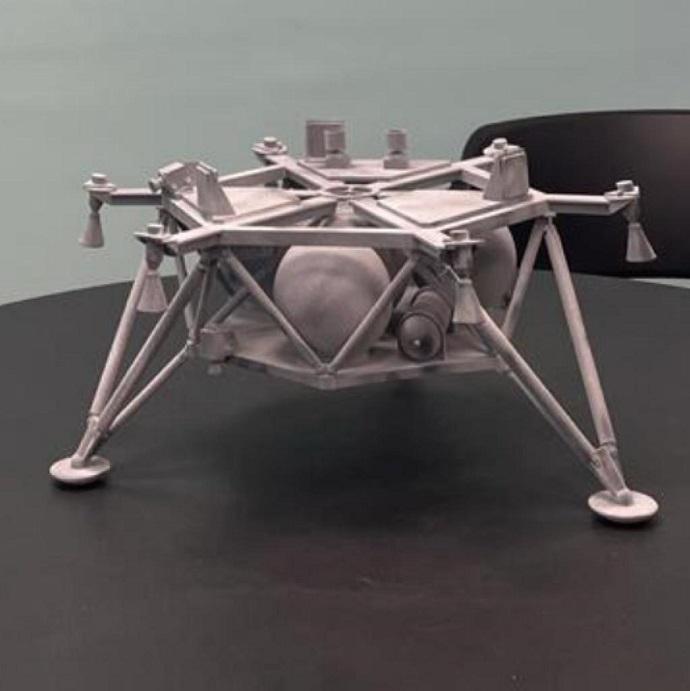Why drive when you can fly? The Israeli startup, WeSpace Technologies, is developing a landing craft that will be able to launch itself autonomously to craters and lava channels on the moon – in the hope of representing Israel in the Artemis program. WeSpace was founded in 2019 by attorneys Yifat Feffer and Yigal Harel, who headed the development of the Israeli spacecraft Beresheet.
"We don't pretend to replace wheeled rovers," Pepper explains. "Even though the area of the Moon is about a quarter of the Earth's surface, and although more than 50 years have passed since man landed on the Moon, information about it is still limited. To date, only about 5% of the lunar surface has been charted in a significant manner. The thing is that rovers with wheels cannot enter craters and lava trenches, some of which are 100 meters deep.
The rocks, the craters, the trenches – all of these have led us to the conclusion that it is better to fly over the obstacles. Unlike rolling rovers that generate electrical energy from solar panels, and can seemingly perform long missions, skipping rovers launch themselves using fuel that is depleted. But as far as performance is concerned, there is no comparison between the two. The typical travel speed of a ground rover is about 0.1 meters per second, while a lunar drone flies at a speed of tens of meters per second, so its level of coverage is much greater. The Chinese rover, which operates on the far side of the moon, has covered 356 meters in a year of activity, almost a meter per day. That is not enough to chart extensive areas of the moon, figure out where to land, where to mine resources and ultimately where to settle."
"Full autonomy is required"
In 2020, NASA launched a helicopter called Ingenuity to Mars, which took off in 2021 and officially became the first aircraft in history to operate in another world. Since then, the Mars drone has been accompanying the rover Perseverance from above, directing the rover's operators to interesting findings in its vicinity. Ingenuity is considered a huge success, and it is expected to become the standard for launching missions to Mars – but the moon does not even have the Red Planet’s thin layer of air.
Our landing craft is similar in performance to the drones that exist on Earth”, says Harel, “except for the propulsion system, which is not a system of propellors, powered by electrical energy, but an array of rocket engines. This is for the simple reason that the moon has almost no atmosphere. The landing craft, whose name is HopLa, is a kind of hopper – hence the name. We are developing a family of “HopLa’s, small, medium and large, to meet a variety of needs that we can see in the market, in terms of carrying capacity and flight range. The main engineering challenge is the drone’s control system, on which we are currently focusing. A fully autonomous pilot is required here, because if we designate HopLa to areas that are hard to reach, such as lava trenches or deep craters in which there are no water deposits, the vehicle will not have any communications with Earth during the mission. HopLa will be required to fly completely autonomously. In order to meet the challenge, we were joined by two experienced systems engineers, who are leading one of Israel’s groundbreaking interception projects.

The Israeli Space Agency is pairing Israeli technology with American capability
After the successful launch of last year's unmanned Artemis 1 mission, next year NASA will send four flesh-and-blood astronauts on a journey around the moon on the Artemis 2 mission. In 2025, Artemis 3 will be launched, in which two of the astronauts — including the first female astronaut and the first black astronaut — will move to SpaceX's Starship and land on the moon for the first time since the Apollo 17 mission in 1972.
However, unlike the Apollo program, the Artemis program is designed to establish a permanent human presence at the south pole of the moon – humanity's first research station on another world. Every year, another Artemis mission will be launched, which will build an international space station in orbit around the moon, and astronauts from the American, European, Canadian, Japanese, and perhaps Israeli, space agencies will live on and around the moon for longer and longer periods, while they learn to take advantage of local resources such as water, oxygen and fuel. Twenty-four countries have already signed the Artemis Accords, which constitute a legal framework for the settlement of the moon in general and for international cooperation in the Artemis program in particular – and the State of Israel is one of them.
"What's on the moon?" asks Feffer. "On the Moon there is ice water, which is very important for use as fuel for spacecraft and is found in ever-shaded craters, there are precious metals such as aluminum and titanium in high concentrations, and there are rare elements that are necessary in fields such as medicine and technology – and here on Earth China produces 90% of them. But in order to reach these resources and mine them, you need to know exactly where they are, which is why the use of a rover capable of moving around by launching is essential. The speed at which a mission covers the area is of great significance. It will take a long time for a rover on wheels to find a concentration of magnesium, so the first vehicle that needs to gather intelligence is the drone. In the long run, we hope to be the "Google Moon", the lunar equivalent of "Google Earth". After we collect the information, we will sell it to a wide range of private and government players. We will open the moon to competition the way Elon Musk has opened the launch market. The Artemis program will provide the lunar landing craft, we will provide the lunar hopper-drones and the information they will collect."
WeSpace hopes to launch a prototype of the "HopLa" as part of the Artemis project, and they are already working with NASA through the Israel Space Agency in the Ministry of Innovation, Science and Technology.
The Israel Space Agency is playing a crucial role in connecting Israeli technology with American capability” says Feffer. The Artemis Accords, to which is Israel is a signatory, form the foundation for the cooperation between the two space agencies, and they spread a national umbrella over Israeli startups like us. We see our project as an Israeli, national project, and we hope to represent our country with dignity – even on the moon”.












